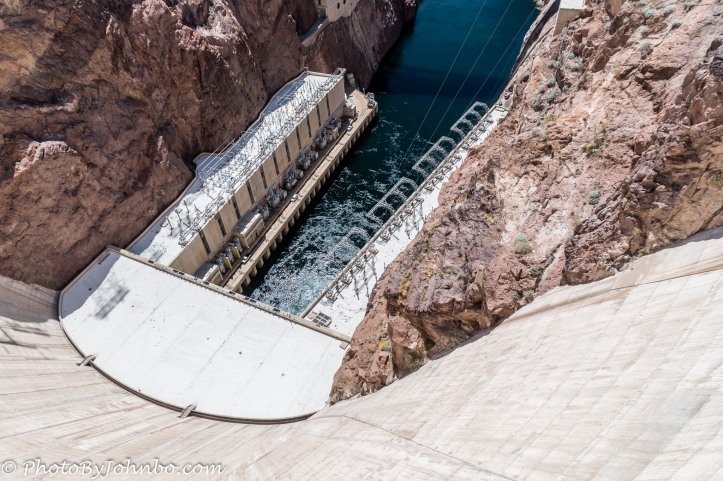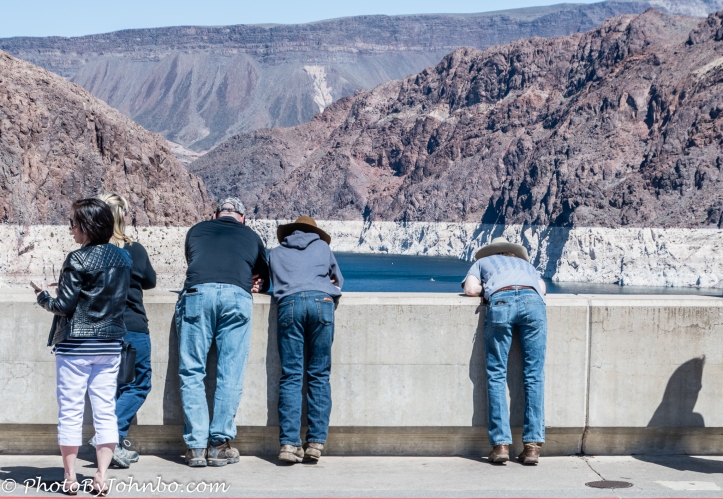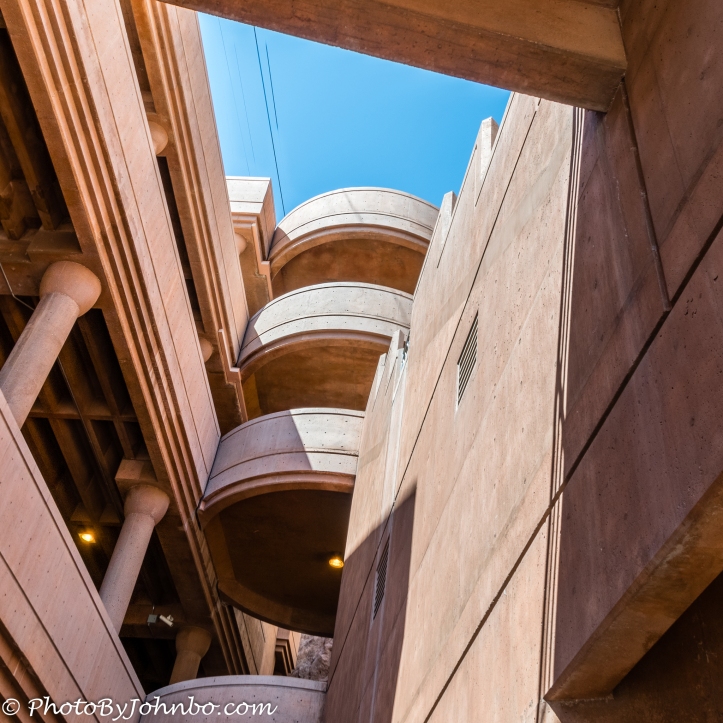A short, 30 mile drive from Las Vegas, the Colorado River is backed up into a huge reservoir known as Lake Meade. The man-made lake was created in the 1930s with the construction of a project originally known as the Boulder Project. Officially, the dam itself was named Hoover Dam after the 31st President, Herbert Clark Hoover in 1947. Bidding for the project opened on March 4, 1931, with first concrete pours on June 6, 1933.
 In addition to providing a storehouse for water, the dam is responsible for the generation of electricity from several large turbines in operation as water flows through the dam and continues on its way down the Colorado River.
In addition to providing a storehouse for water, the dam is responsible for the generation of electricity from several large turbines in operation as water flows through the dam and continues on its way down the Colorado River.
 The dam is a huge tourist attraction. We waited in traffic as it slowly moved from Boulder City into the area of the dam. There is a large parking area on the Arizona side of the dam, and a new parking ramp on the Nevada side of the dam. In the photo above, people are looking down at the Lake Meade side of the dam. In the background, it looks like someone painted a large white stripe on the rocks. The top of that white stripe shows the historic water level high. The level of the dam is much lower these days exposing the water-bleached rock on the canyon walls.
The dam is a huge tourist attraction. We waited in traffic as it slowly moved from Boulder City into the area of the dam. There is a large parking area on the Arizona side of the dam, and a new parking ramp on the Nevada side of the dam. In the photo above, people are looking down at the Lake Meade side of the dam. In the background, it looks like someone painted a large white stripe on the rocks. The top of that white stripe shows the historic water level high. The level of the dam is much lower these days exposing the water-bleached rock on the canyon walls.
 In 1935, the last concrete is placed on May 29, but it takes another year before the first generators start production of electricity. By 1939, the lake is storing more than 8 trillion gallons of water and by 1940, power generation is at 3 billion kilowatt-hours. The last generator went online in 1961 and by the 50th anniversary of completion in 1985, the Federal Treasury was almost completely repaid for the construction costs. The monument in the photo above honors the many workers who lost their lives in construction accidents. Building on the Boulder Project was a very dangerous occupation.
In 1935, the last concrete is placed on May 29, but it takes another year before the first generators start production of electricity. By 1939, the lake is storing more than 8 trillion gallons of water and by 1940, power generation is at 3 billion kilowatt-hours. The last generator went online in 1961 and by the 50th anniversary of completion in 1985, the Federal Treasury was almost completely repaid for the construction costs. The monument in the photo above honors the many workers who lost their lives in construction accidents. Building on the Boulder Project was a very dangerous occupation.
 Travelers between Phoenix and Las Vegas using US Highway 93 get a great view of the dam as they cross the Colorado River via the beautifully architected bridge that spans the upper walls of the canyon. A parking area near the bridge allows people to leave their cars and walk along a protected walkway to take a break from travelling and get a great view of the magnificent dam just upriver. This view of the bridge is from the top of the dam.
Travelers between Phoenix and Las Vegas using US Highway 93 get a great view of the dam as they cross the Colorado River via the beautifully architected bridge that spans the upper walls of the canyon. A parking area near the bridge allows people to leave their cars and walk along a protected walkway to take a break from travelling and get a great view of the magnificent dam just upriver. This view of the bridge is from the top of the dam.
 Traffic and parking are major issues for those visiting the site. A newly constructed parking ramp helps alleviate the congestion. The tours of the dam’s interior were stopped for some time after September 11, 2001, but they are back in place now, though I’m told they don’t go quite as deep into the interior as they had in the past. The gallery of images below features views of the dam and surrounding area. In most browsers, you can click on an image to enlarge it and to scroll through the gallery.
Traffic and parking are major issues for those visiting the site. A newly constructed parking ramp helps alleviate the congestion. The tours of the dam’s interior were stopped for some time after September 11, 2001, but they are back in place now, though I’m told they don’t go quite as deep into the interior as they had in the past. The gallery of images below features views of the dam and surrounding area. In most browsers, you can click on an image to enlarge it and to scroll through the gallery.
Information for this article was sourced from the Bureau of Reclamation here.
John Steiner













Super cool! Things like this, make me realize all the stuff we miss because we fly.
Yup, but it sure takes time. 😀
I was lucky enough to visit the dam, it’s such an incredible piece of engineering. Photos don’t do it just on just how big it actually is. Great pics makes me want to be back there again.
Indeed, photos are inadequate to compare the relative size of the dam.